As a leader in the field of textile conservation, Julia Brennan has worked to preserve many glamorous and historic articles of clothing, from a kimono presented to Babe Ruth, to singer James Brown’s jumpsuit, to a British aristocrat’s coronation gown.
However, her profession has also brought her into contact with humanity’s darkest moments, including genocides in Rwanda and Cambodia.
Brennan recently began a project at the Tuol Sleng Genocide Museum in Phnom Penh, where the Khmer Rouge in the late 1970s tortured as many as 17,000 men, women and children before killing them. The museum’s macabre artifacts include torture devices and displays of skulls.
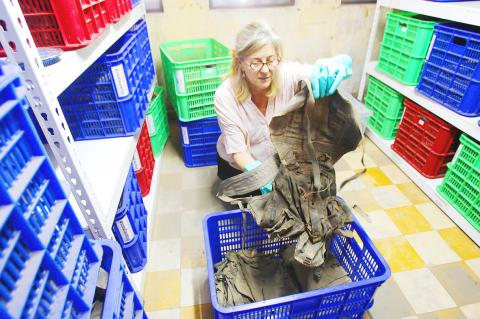
Photo: AP
The most haunting display comprises photographic portraits that were kept as part of the meticulous record-keeping ordered by Tuol Sleng’s Khmer Rouge commander, who in 2012 was sentenced to life in prison for crimes against humanity, murder and torture.
However, only a small amount of victims’ clothing is displayed; most was stowed away in nooks and crannies, untouched since the museum was established in 1980.
Museum director Chhay Visoth felt it was urgent to register and preserve these holdings, and he sought Brennan’s help in 2014.
Brennan was keenly interested in the Tuol Sleng project, and the US embassy in Phnom Penh eventually gave a US$55,000 grant to support it.
She then began her work to jump-start the preservation of 3,000 to 5,000 articles of prisoners’ clothing and train Cambodian staff to care for them.
Brennan for the past two years worked on a similar project in Rwanda, where long-standing rivalries between two tribes led to the killings of an estimated 800,000 people in 1994.
She helped to preserve clothing at the Nyamata church, where more than 10,000 people were slaughtered as they sought shelter from marauding mobs. The church is now a memorial site, with the clothing an integral part of its exhibition.
The power of clothing in documenting genocide is widely recognized. The collection at the Auschwitz-Birkenau Memorial and Museum in Poland includes 390 striped inmates’ uniforms and 246 Jewish prayer shawls, memorial press officer Pawel Sawicki said.
The US Holocaust Memorial Museum in Washington holds a variety of items of clothing as well. One of the most striking exhibits is of 4,000 shoes from some of the victims of the Majdanek concentration camp in Poland.
“The exhibit very simply shows the magnitude of Nazi murder, while simultaneously allowing the viewer to individualize the horror,” museum chief conservator Jane Klinger said in an e-mail.
Brennan, who since 1996 has had her own company in Washington, Caring for Textiles, made a similar point during an interview at Tuol Sleng.
“You’re not going to necessarily cry or have memories when you see a skull, but when you see a skirt that’s the same pattern as your mother’s, then that’s going to bring these memories that are so palpable, and this is so powerful,” she said.
Less is more in conservation, “because we want to keep the associated dirt and stains and particles as part of the context and information of the artifact,” she added.
For Tuol Sleng’s artifacts, she said she has been teaching half a dozen Cambodian colleagues to photograph a piece to identify it for inventory, “then just to surface clean carefully with a vacuum or a soft brush, and then the dirt can be saved as part of the record and some of the surface soiling will be loosened.”
To try to protect the material for the long term, it is put into “micro-climates” in which the relative humidity can be reduced.
Brennan said she developed this system during her work in Rwanda, putting the items in dry storage boxes with desiccants, pellets normally used in the agriculture industry.
Kho Chenda, a 28-year-old staff member at Tuol Sleng, has taken Brennan’s preservation lessons to heart. She said what she has learned is vital, because of the museum’s mission to teach the horrific legacy of the Khmer Rouge.
“If that clothing gets too old and worn out, then the evidence it offers will be gone, and when you talk to the younger generation, they will not believe you,” she said.
Kong Kuntheary, another of Brennan’s students, echoed the sentiment.
“This clothing is really important evidence, so we have to preserve it to make sure that even in 100 or 200 years, it will not have disappeared,” Kong Kuntheary said.
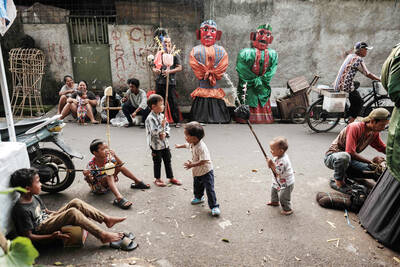
In the sweltering streets of Jakarta, buskers carry towering, hollow puppets and pass around a bucket for donations. Now, they fear becoming outlaws. City authorities said they would crack down on use of the sacred ondel-ondel puppets, which can stand as tall as a truck, and they are drafting legislation to remove what they view as a street nuisance. Performances featuring the puppets — originally used by Jakarta’s Betawi people to ward off evil spirits — would be allowed only at set events. The ban could leave many ondel-ondel buskers in Jakarta jobless. “I am confused and anxious. I fear getting raided or even
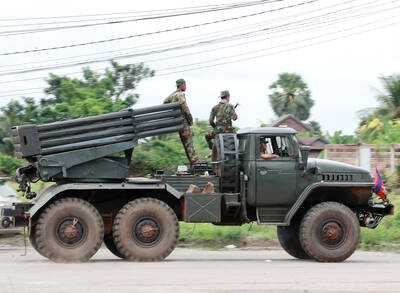
POLITICAL PATRIARCHS: Recent clashes between Thailand and Cambodia are driven by an escalating feud between rival political families, analysts say The dispute over Thailand and Cambodia’s contested border, which dates back more than a century to disagreements over colonial-era maps, has broken into conflict before. However, the most recent clashes, which erupted on Thursday, have been fueled by another factor: a bitter feud between two powerful political patriarchs. Cambodian Senate President and former prime minister Hun Sen, 72, and former Thai prime minister Thaksin Shinawatra, 76, were once such close friends that they reportedly called one another brothers. Hun Sen has, over the years, supported Thaksin’s family during their long-running power struggle with Thailand’s military. Thaksin and his sister Yingluck stayed
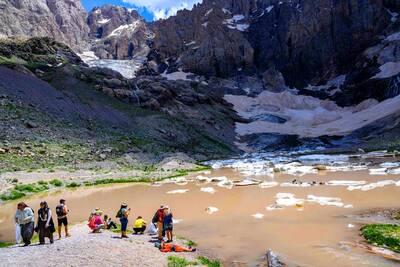
Kemal Ozdemir looked up at the bare peaks of Mount Cilo in Turkey’s Kurdish majority southeast. “There were glaciers 10 years ago,” he recalled under a cloudless sky. A mountain guide for 15 years, Ozdemir then turned toward the torrent carrying dozens of blocks of ice below a slope covered with grass and rocks — a sign of glacier loss being exacerbated by global warming. “You can see that there are quite a few pieces of glacier in the water right now ... the reason why the waterfalls flow lushly actually shows us how fast the ice is melting,” he said.
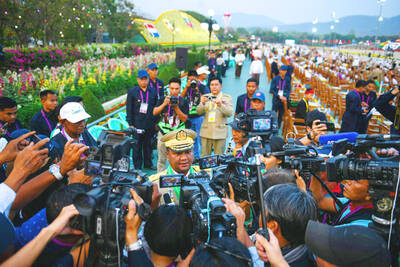
RESTRUCTURE: Myanmar’s military has ended emergency rule and announced plans for elections in December, but critics said the move aims to entrench junta control Myanmar’s military government announced on Thursday that it was ending the state of emergency declared after it seized power in 2021 and would restructure administrative bodies to prepare for the new election at the end of the year. However, the polls planned for an unspecified date in December face serious obstacles, including a civil war raging over most of the country and pledges by opponents of the military rule to derail the election because they believe it can be neither free nor fair. Under the restructuring, Myanmar’s junta chief Min Aung Hlaing is giving up two posts, but would stay at the